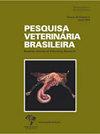腹侧斜脑膜瘤犬患肺炎的频率增加
IF 0.8
4区 农林科学
Q3 VETERINARY SCIENCES
引用次数: 0
摘要
摘要:发生在脑桥小脑角等特定脑区的颅内肿瘤可能与人畜脑神经功能障碍和吞咽困难有关。虽然吞咽困难是肺炎的已知危险因素,但在兽医学中仅对术后肺炎进行了研究。本研究旨在描述未经治疗的颅内脑膜瘤并发肺炎犬的临床和病理特征。使用2011年至2021年尸检登记的数据(n=23)。比较腹侧斜脑区脑膜瘤犬肺炎发生频率等特征(VR组;n=13)及颅内其他部位脑膜瘤患者(OIS组;n = 10)。VR组肺炎发生频率高于OIS组(n=5 vs. n=0;P = 0.039)。斑块样病变在VR组也比OIS组更常见(P=0.012)。伴发肺炎的犬有脑桥小脑角(n=3)和基底脑膜瘤(n=2),主要是向其他脑区或向其他脑区延伸的斑块样病变。在合并肺炎的犬中,脑膜瘤具有侵袭性(n=5)和压缩性(n=3)的生长行为,参与吞咽过程的神经根经常受到影响。显微镜下,这些脑膜瘤分为非典型脑膜瘤(n=4)和脑膜瘤(n=1)。报告的临床症状包括厌食(n=3)、厌食(n=1)和吞咽困难(n=1)。我们的研究结果表明,未经治疗的腹侧斜脑膜瘤犬可能发生脑神经损伤和吸入性肺炎。本文章由计算机程序翻译,如有差异,请以英文原文为准。
Increased frequency of pneumonia in dogs with meningioma in ventral rhombencephalon
ABSTRACT: Intracranial tumors occurring in specific brain regions, such as the cerebellopontine angle, may be associated with cranial nerve dysfunction and dysphagia in humans and animals. Although dysphagia is a known risk factor for pneumonia, only postoperative pneumonia has been investigated in veterinary medicine. This study aimed to describe the clinical and pathological features of dogs with untreated intracranial meningiomas and concomitant pneumonia. Data from post-mortem examination registries from 2011 to 2021 were used (n=23). The frequency of pneumonia and other characteristics were compared between dogs with meningiomas in the ventral rhombencephalon region (VR group; n=13) and those with meningiomas in other intracranial sites (OIS group; n=10). The frequency of pneumonia was higher in the VR group than in the OIS group (n=5 vs. n=0; P=0.039). Plaque-like lesions were also more common in the VR group than in the OIS group (P=0.012). Dogs with concomitant pneumonia had cerebellopontine angle (n=3) and basilar meningiomas (n=2), mainly plaque-like lesions extending to or from other brain areas. In dogs with concomitant pneumonia, meningiomas had invasive (n=5) and compressive (n=3) growth behaviors and nerve roots involved in the swallowing process were frequently affected. Microscopically, these meningiomas were classified as atypical (n=4) and meningiomas (n=1). The reported clinical signs included anorexia (n=3), adipsia (n=1), and dysphagia (n=1). Our findings suggest untreated dogs with ventral rhombencephalon meningiomas may develop cranial nerve damage and aspiration pneumonia.
求助全文
通过发布文献求助,成功后即可免费获取论文全文。
去求助
来源期刊

Pesquisa Veterinaria Brasileira
农林科学-兽医学
CiteScore
1.30
自引率
16.70%
发文量
41
审稿时长
9-18 weeks
期刊介绍:
Pesquisa Veterinária Brasileira - Brazilian Journal of Veterinary Research (http://www.pvb.com.br), edited by the Brazilian College of Animal Pathology in partnership with the Brazilian Agricultural Research Organization (Embrapa) and in collaboration with other veterinary scientific associations, publishes original papers on animal diseases and related subjects. Critical review articles should be written in support of original investigation. The editors assume that papers submitted are not being considered for publication in other journals and do not contain material which has already been published. Submitted papers are peer reviewed.
The abbreviated title of Pesquisa Veterinária Brasileira is Pesqui. Vet. Bras.
 求助内容:
求助内容: 应助结果提醒方式:
应助结果提醒方式:


